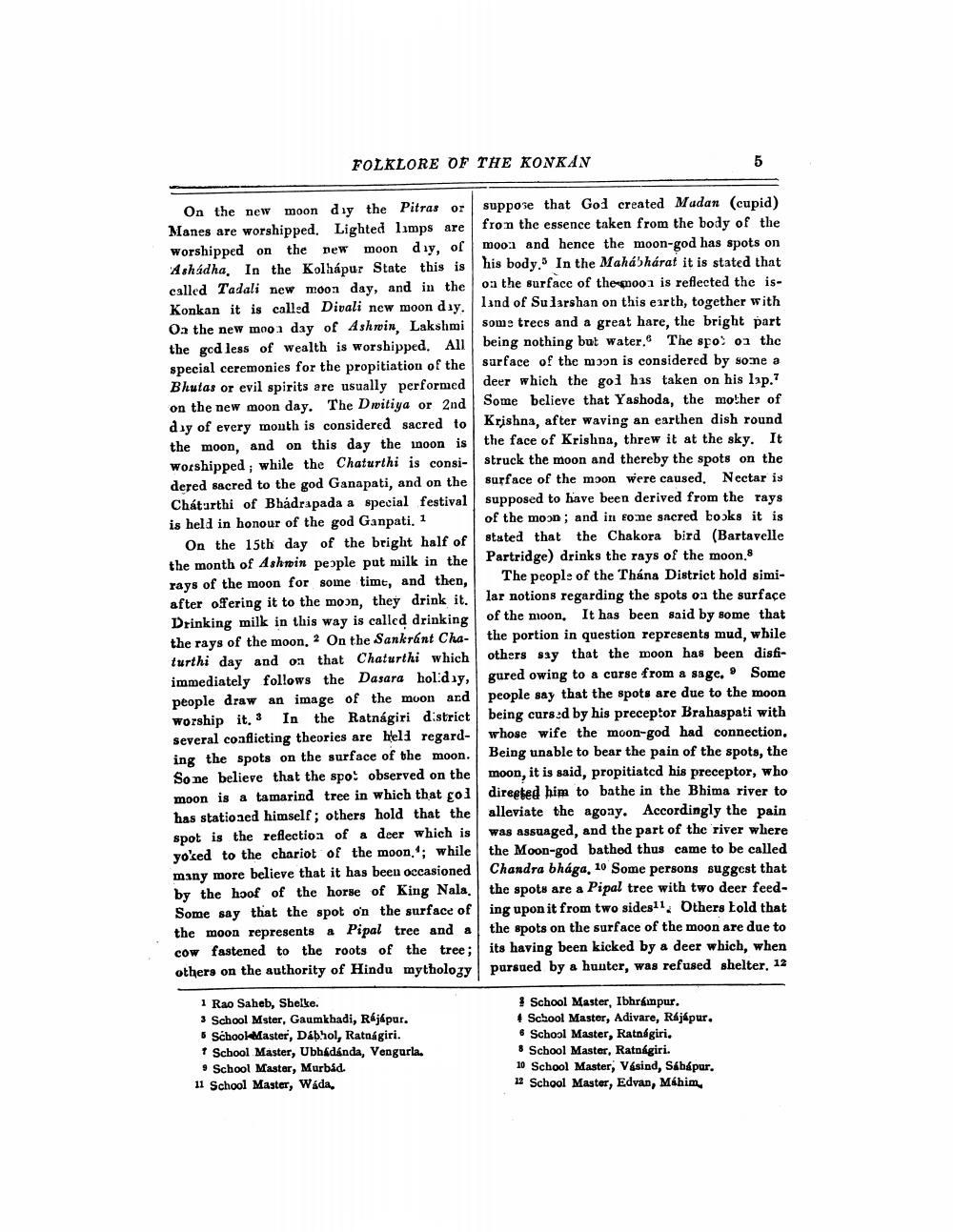________________
FOLKLORE OF THE KONKAN
On the new moon day the Pitras or Manes are worshipped. Lighted lamps are worshipped on the new moon day, of Ashadha, In the Kolhápur State this is called Tadali new moon day, and in the Konkan it is called Divali new moon day. On the new moon day of Ashwin, Lakshmi the god less of wealth is worshipped. All special ceremonies for the propitiation of the Bhutas or evil spirits are usually performed on the new moon day. The Dwitiya or 2nd day of every month is considered sacred to the moon, and on this day the noon is worshipped; while the Chaturthi is considered sacred to the god Ganapati, and on the Cháturthi of Bhadrapada a special festival is held in honour of the god Ganpati, 1
On the 15th day of the bright half of the month of Ashwin people put milk in the rays of the moon for some time, and then, after offering it to the moon, they drink it. Drinking milk in this way is called drinking the rays of the moon. 2 On the Sankrant Chaturthi day and on that Chaturthi which immediately follows the Dasara holiday, people draw an image of the moon and worship it. 3 In the Ratnagiri district several conflicting theories are held regarding the spots on the surface of the moon. Sone believe that the spo: observed on the moon is a tamarind tree in which that gol has stationed himself; others hold that the spot is the reflection of a deer which is yoked to the chariot of the moon.'; while many more believe that it has been occasioned by the hoof of the horse of King Nala, Some say that the spot on the surface of the moon represents a Pipal tree and a cow fastened to the roots of the tree; others on the authority of Hindu mythology
1 Rao Saheb, Shelke.
3 School Mster, Gaumkhadi, Rájápur.
5 School Master, Dábhol, Ratnagiri.
↑ School Master, Ubhádánda, Vengurla.
School Master, Murbád.
11 School Master, Wáda,
suppose that God created Madan (cupid) from the essence taken from the body of the moon and hence the moon-god has spots on his body." In the Mahábhárat it is stated that oa the surface of the moon is reflected the island of Sudarshan on this earth, together with some trees and a great hare, the bright part being nothing but water. The spo: on the surface of the moon is considered by some a deer which the gol has taken on his lap.7 Some believe that Yashoda, the mother of Krishna, after waving an earthen dish round the face of Krishna, threw it at the sky. It struck the moon and thereby the spots on the surface of the moon were caused. Nectar is supposed to have been derived from the rays of the moon; and in some sacred books it is
5
stated that the Chakora bird (Bartavelle Partridge) drinks the rays of the moon,8
The people of the Thána District hold similar notions regarding the spots on the surface of the moon. It has been said by some that the portion in question represents mud, while others say that the moon has been disfigured owing to a curse from a sage, Some people say that the spots are due to the moon being cursed by his preceptor Brahaspati with whose wife the moon-god had connection. Being unable to bear the pain of the spots, the moon, it is said, propitiated his preceptor, who directed him to bathe in the Bhima river to alleviate the agony. Accordingly the pain was assuaged, and the part of the river where the Moon-god bathed thus came to be called Chandra bhága, 10 Some persons suggest that the spots are a Pipal tree with two deer feeding upon it from two sides11. Others told that the spots on the surface of the moon are due to its having been kicked by a deer which, when pursued by a hunter, was refused shelter, 12
School Master, Ibhrampur.
# School Master, Adivare, Rájápur.
6 School Master, Ratnagiri.
8 School Master, Ratnagiri.
10 School Master, Vásind, Sábápur.
12 School Master, Edvan, Máhim,




